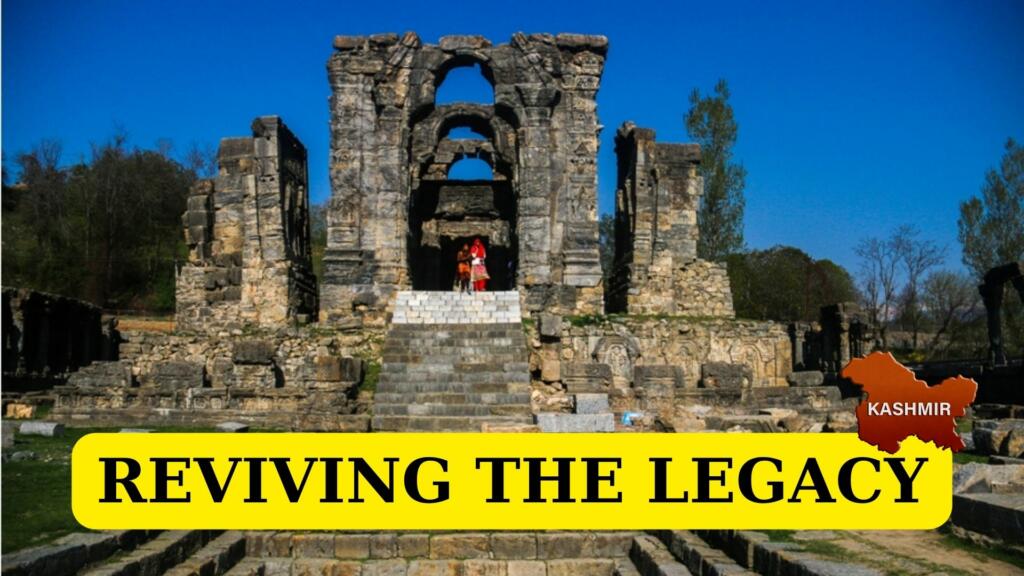The Martand Sun Temple, nestled in the picturesque landscapes of Jammu & Kashmir, stands as a revered sanctuary dedicated to the Deity Sun. Its towering spires and intricate carvings bear testament to a bygone era of architectural magnificence and spiritual devotion. Like its counterparts, such as Konark in Orissa and Modhera in Gujarat, Martand holds a distinguished place in India’s religious landscape, echoing centuries of cultural heritage and artistic brilliance. As an iconic Hindu temple, it not only honors the celestial deity but also serves as a timeless reminder of the enduring legacy of devotion and craftsmanship in Indian civilization.
The Back Story
The Martand Sun Temple stands as a testament to ancient Kashmir’s rich cultural and architectural heritage. Constructed in the 7th century AD, during the reign of Emperor Lalitaditya Muktapida, it served as a grand tribute to the Deity Sun, revered widely in Hinduism.
Who was Lalitaditya?
Emperor Lalitaditya Muktapida, a prominent ruler of the Karkota dynasty, ascended to the throne in the 7th century. His reign, as chronicled in the Rajatarangini by historian Kalhana, was marked by a remarkable period of prosperity and cultural flourishing in the region. Under Lalitaditya’s rule, Kashmir witnessed advancements in various fields, including architecture, literature, and trade. His patronage of the arts and his encouragement of scholarly pursuits contributed significantly to the cultural vibrancy of the era.
The construction
The building of the Martand Sun Temple stands as one of Lalitaditya’s most enduring legacies. Built in honor of the Sun God, or Bhaskar, the temple showcased the architectural prowess and artistic finesse of the time. Its grandeur and intricate design reflected the zenith of Kashmiri craftsmanship.
However, despite the temple’s significance as a symbol of cultural and religious devotion, it faced the tragic fate of destruction. Sultan Sikandar Shah Miri, also known as Sikandar Butshikan, ascended to power in the 14th century. Infamous for his zeal to Islamize Kashmir and suppress non-Muslim practices, Sikandar ordered the destruction of numerous Hindu temples, including the revered Martand Sun Temple. This act of religious intolerance and iconoclasm not only erased a magnificent architectural marvel but also left a scar on Kashmir’s cultural landscape.
Also Read: India’s Strong Warning: “Hands off” Jammu and Kashmir, Pakistan and Turkey told
The Demolition
The collapse of the Martand Sun Temple serves as a poignant reminder of the religious tensions that have marred Kashmir’s history. It highlights the destructive consequences of religious intolerance and the importance of preserving cultural heritage as a testament to pluralism and tolerance.
Despite its tragic demise, the Martand Sun Temple remains an enduring symbol of Kashmir’s rich heritage and serves as a poignant reminder of the need to safeguard cultural treasures from the ravages of time and conflict. The decision to renovate and restore this ancient marvel is not just a restoration of stone and mortar but a reaffirmation of Kashmir’s diverse cultural tapestry and a tribute to the resilience of its people.
Also Read: From blasts to blossoms: PM Modi’s vision transforms J&K post 370
Renovation Plans
The Jammu & Kashmir government’s recent decision to restore the Martand Sun Temple and honor its legacy by erecting a statue of King Lalitaditya represents a significant step towards preserving the region’s cultural heritage. The restoration project reflects a commitment to safeguarding ancient monuments and promoting religious diversity and tolerance.
In an official order issued by the government, emphasis was placed on the protection, conservation, and restoration of ancient temples in Kashmir, with a particular focus on the Martand Sun Temple. The directive underscores the importance of preserving these architectural marvels as integral parts of the region’s identity and history.
Current Developments
Recently, the visit by Lieutenant Governor Manoj Sinha to the Martand Sun Temple has garnered attention. His participation in the Mahayagya organized by the Shri Martand Tirath Trust signifies official support for efforts to revive the temple and preserve its cultural significance. The Lieutenant Governor’s presence underscores the importance of the temple as a symbol of communal harmony and spiritual heritage.
In another notable development, a ‘Kalash’ originally from Ayodhya was installed at the Ram Temple situated on the grounds of the Martand Sun Temple. This act of unity among residents and devotees from various regions highlights the widespread reverence for the temple and the shared commitment to its restoration. The installation of the ‘Kalash’ serves as a symbol of solidarity and collective effort in preserving the temple’s sanctity and historical legacy.
Also Read: Modi’s Dream Transforming into Reality: Kashmir Hosts its First Ever Formula-4 Car Race
Architectural Significance
The Martand Sun Temple stands as a remarkable architectural marvel, showcasing the ingenuity and skill of ancient Kashmiri Hindu builders. Its unique design, characterized by intricate carvings, towering columns, and elaborate spires, reflects a fusion of artistic finesse and religious devotion. The temple’s layout, meticulously planned according to Vastu science, demonstrates an advanced understanding of architectural principles and cosmic harmony.
The temple’s significance extends beyond its physical beauty; it serves as a testament to the unparalleled expertise of Kashmiri Hindu builders of ancient times. The precision with which the temple was constructed, combined with the intricacy of its ornamentation, speaks to the mastery of craftsmanship achieved by these artisans. Each aspect of the temple, from its grand entrance to its sanctum housing the idol of the Sun God, showcases the dedication and skill of its creators.
The Martand Sun Temple holds immense significance in Jammu & Kashmir’s cultural heritage, symbolizing the region’s rich history and spiritual legacy. Its restoration not only preserves a magnificent architectural marvel but also honors the craftsmanship of ancient Kashmiri builders and promotes religious tolerance. As part of India’s cultural identity, temples like Martand are invaluable treasures, serving as tangible links to the past and sources of inspiration for future generations. It is imperative to safeguard and celebrate these heritage sites, ensuring their preservation for posterity and enriching India’s cultural tapestry.
Also Read: After 370, Amit Shah’s Signal to Revoke AFSPA in Jammu & Kashmir
